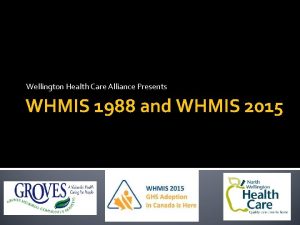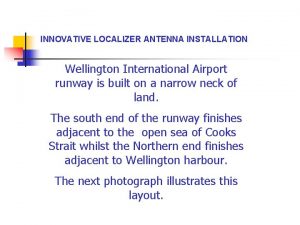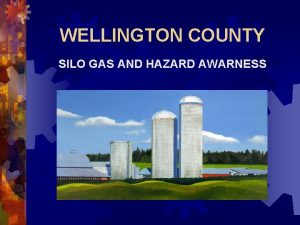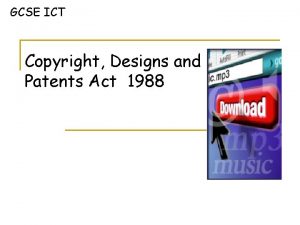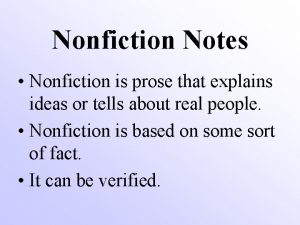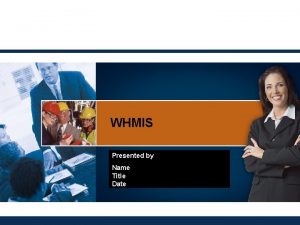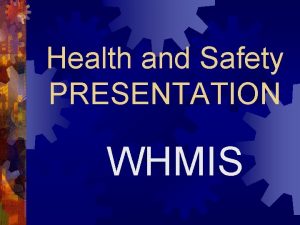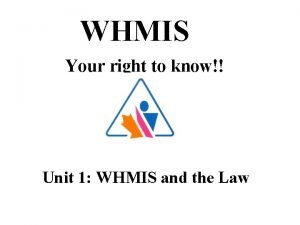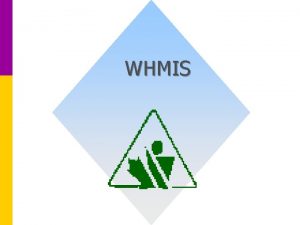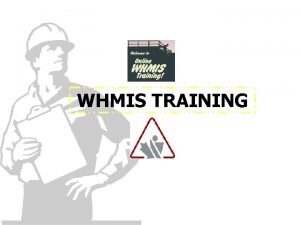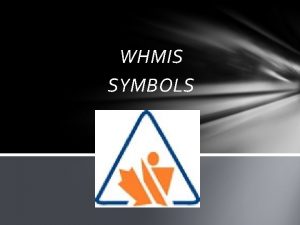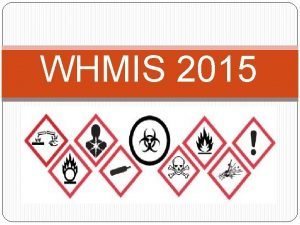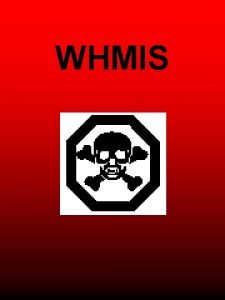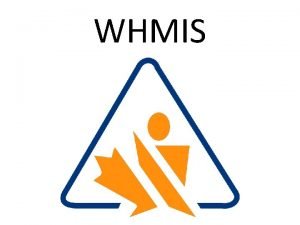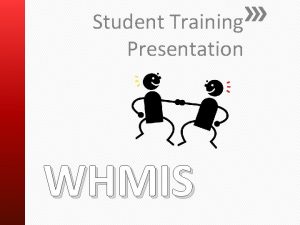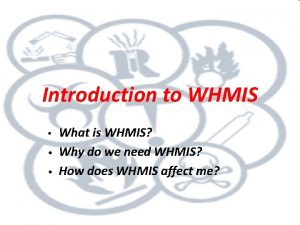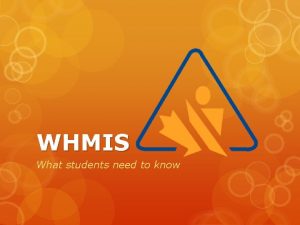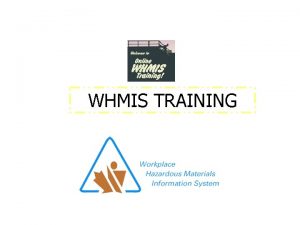Wellington Health Care Alliance Presents WHMIS 1988 and






















- Slides: 22

Wellington Health Care Alliance Presents WHMIS 1988 and WHMIS 2015

What is WHMIS? WHMIS stands for Workplace Hazardous Materials Information System The purpose of WHMIS is to reduce injury, illness or disease caused by exposure to hazardous materials. WHMIS is law under the Canada Labour Code and is applied in Ontario as a regulation under the Occupational Health and Safety Act (OHSA). All staff MUST complete WHMIS training WHMIS covers all products considered “hazardous”

Which products are not under WHMIS? Pest control products (Pest Control Products Act) Consumer products (Canada Consumer Product Safety Act) Pharmaceuticals, cosmetic, and food (Food and Drugs Act) Wood or products made of wood Nuclear substances (Nuclear Safety and Control Act) Explosives (Explosives Act) Hazardous waste being a hazardous product that is sold for recycling or recovery and is intended for disposal. Tobacco and tobacco products (Tobacco Act) NOTE: while a product may not be under the requirement to have a WHMIS label and SDS (Safety Data Sheets); employers must provide education and training on these products.

New to WHMIS 2015 1. 2. 3. 4. 5. 6. Globally Harmonized System of Classification and Labelling of Chemicals (GHS) has been adopted Products previously called “controlled” are now called “hazardous” Material Safety Data Sheets (MSDS) are now called Safety Data Sheets (SDS); with no expiry dates Pictograms on labels and Safety Data Sheets have changed Signal words such as “Danger” have been added to Supplier Labels More information have been added to Supplier Labels and Safety Data Sheets

What is GHS? What are the benefits of GHS? WHMIS has aligned with the worldwide hazard communication system known as GHS – the Globally Harmonized System of Classification and Labelling of Chemicals Aligning with GHS provides many benefits, including: More comprehensive hazard classification criteria New hazard classes include physical and health hazards Physical hazard criteria are consistent with the Transport of Dangerous Goods Standardized language (hazard and precautionary statements). Standardized SDS format and more comprehensive requirements.

Product Example prior to GHS For product X (prior to GHS) it would be labelled as: Country Label (prior to GHS labelling) North America Toxic Australia and Europe Harmful China Moderately Toxic New Zealand Hazardous India Non-toxic Imagine the legal complications and difficulty of exporting/importing this product from one country to another. Imagine the number of different labels required for this product let alone how you accurately communicate the hazards associated with this product to workers who might use it.

Basically… WHMIS 1988 + GHS = WHMIS 2015

Supplier’s Duties Suppliers who sell or import hazardous products must classify hazardous products. Classification is determined based on comparison of all available hazard data for the ingredients or mixture to the WHMIS requirements. When a product is a hazardous product, the supplier must label the product or container and they must provide a safety data sheet (SDS) to their customers.

Employer’s Duties Educate and train workers on the hazards, safe storage, handling, and use of the hazardous products Ensure hazardous products are properly labelled Prepare workplace labels and safety data sheets (SDS) if required Provide workers with access to up-to-date labels and SDS

Worker’s Duties Follow safe work procedures and use required Personal Protective Equipment (PPE) when handling a WHMIS product Notify your employer or supervisor about problems with labels and safety data sheets (SDS), such as improper or missing information Report any violations of the Occupational Health and Safety Act or WHMIS to their manager/supervisor

Why do I require training on both WHMIS 1988 and 2015? The transition time is present. Suppliers have until May 31, 2017 to transition WHMIS 1988 labels/MSDS to WHMIS 2015 labels/SDS Distributors have until May 31, 2018 to transition from WHMIS 1988 Employers have until November 30, 2018 to educate staff on WHMIS 2015 All staff will be educated on both systems during the transition time. Once the transition is complete, staff will solely be educated on WHMIS 2015

WHMIS 2015 Pictograms

WHMIS 1988 Hazard Symbols You will continue to find WHMIS 1988 hazard symbols on products until the suppliers have transitioned over to WHMIS 2015

Pictogram Checkpoint: Match the pictogram with the description Corrosive Oxidizing Hazards Health Hazard

Answers Pictogram Checkpoint: Match the pictogram with the description Corrosive Oxidizing Hazards Health Hazard

Supplier Labels WHMIS 1988 vs. WHMIS 2015 WHMIS 1988 A supplier label must: appear on all controlled products received at workplaces in Canada contain the following information: name of product/product identifier name of supplier a statement that an MSDS is available hazard symbols risk phrases precautionary measures first aid measures have all text in English and French have the WHMIS hatched border. WHMIS 2015 A supplier label must: appear on all hazardous products received at workplaces in Canada contain the following information: name of product/product identifier name of supplier a statement that a SDS is available pictogram: with a red diamond shape signal word: a single word to alert reader of hazard and it’s severity (ie. Danger) hazard statement: describing the nature of the hazard precautionary statement: measures taken place to prevent adverse event supplemental label information Information of distributer if the hazardous product is imported and distributed Have all text in English and French

Sample WHMIS 2015 Supplier Label Name of product Pictogram Signal word Hazard Statement Precautionary Statement Supplemental Label Information Name of Supplier

Workplace Labels WHMIS 1988 vs. WHMIS 2015 WHMIS 1988 A workplace label must: appear on all controlled products produced in a workplace or transferred to other containers by the employer have the following information: product identifier (product name) information for the safe handling of the product statement that the MSDS is available may contain the WHMIS hazard symbols or other pictograms. WHMIS 2015 A workplace label must: appear on all hazardous products produced in a workplace or transferred to other containers by the employer Replace a lost or illegible supplier label have the following information: Product name (matching the SDS product name). Safe handling precautions, may include pictograms or other supplier label information. a reference to the SDS *If the hazardous product is always used in the container with the supplier label, no other label is required.

MSDS vs. SDS MSDS have 9 information points: 1. 2. 3. 4. 5. 6. 7. 8. 9. Product Information: product identifier (name), manufacturer and suppliers names, addresses, and emergency phone numbers Hazardous Ingredients Physical Data Fire or Explosion Hazard Data Reactivity Data: information on the chemical instability of a product and the substances it may react with Toxicological Properties: health effects Preventive Measures First Aid Measures Preparation Information: who is responsible for preparation and date of preparation of MSDS have 16 information points: 1. Identification 2. Hazard(s) identification 3. Composition/information on ingredients 4. First-aid measures 5. Fire-fighting measures 6. Accidental release measures 7. Handling and Storage 8. Exposure controls/personal protection 9. Physical and chemical properties 10. Stability and reactivity 11. Toxicological information 12. Ecological information 13. Disposal considerations 14. Transport information 15. Regulatory information 16. Other information

How to Prevent Exposures Receive education on how to use hazardous products Wear PPE correctly if indicated Review MSDS/SDS-> They are on the homepage on the intranet… When in doubt, ask questions

WHMIS QUIZ: For GMCH Staff: For NWHC Staff: Click on the link: www. testmoz. com/687928 *If you are having trouble opening the link, right click the mouse on the link and click on “Open Hyperlink” 2. Type your FIRST and LAST name in the box labelled name 3. Password: GMCH 4. Complete the five questions 5. Your results will automatically be recorded Click on the link: www. testmoz. com/711551 *If you are having trouble opening the link, right click the mouse on the link and click on “Open Hyperlink” 2. Type your FIRST and LAST name in the box labelled name 3. Password: NWHC 4. Complete the five questions 5. Your results will automatically be recorded 1.

References Canadian Center for Occupational Health and Safety www. ccohs. ca Ontario Ministry of Labour http: //www. labour. gov. on. ca/english/hs/pubs/ohsa/ MSDS Online www. msdsonline. com
 Whmis 1988 pictograms
Whmis 1988 pictograms Primary school camp packing list
Primary school camp packing list Alliance for better health care llc
Alliance for better health care llc Health and social component 3
Health and social component 3 Localizer antenna array
Localizer antenna array Berf wellington
Berf wellington Wellington high night classes
Wellington high night classes Wellington shelton
Wellington shelton Wellington eagles
Wellington eagles Gas law wellington
Gas law wellington Wellington trotta
Wellington trotta Wellington the curious incident
Wellington the curious incident Wellington napoleon
Wellington napoleon Mypbchoiceapp
Mypbchoiceapp Unit 2 equality diversity and rights
Unit 2 equality diversity and rights Primary secondary tertiary medical care
Primary secondary tertiary medical care What is the copyright designs and patents act 1988
What is the copyright designs and patents act 1988 Copyright designs and patents act 1988 examples
Copyright designs and patents act 1988 examples Fazey and hardy (1988) activity worksheet
Fazey and hardy (1988) activity worksheet Identify the text structure of the following passage
Identify the text structure of the following passage Prose writing that presents and explains ideas
Prose writing that presents and explains ideas Prose writing that presents and explains ideas
Prose writing that presents and explains ideas What is structure in drama
What is structure in drama
